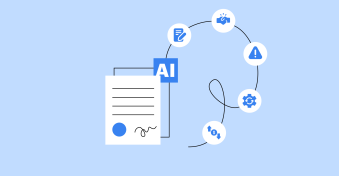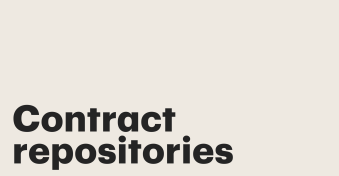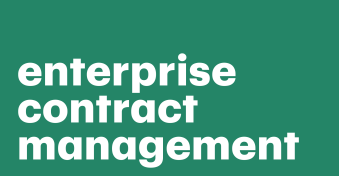According to a 2021 report, most business leaders said that poor contracting processes have resulted in slower revenue.
Furthermore, half of those surveyed globally stated they are missing out on business.
Poor contracting management leads to missed deadlines, revenue delays, and costly disputes.
The good news is that transformative AI solutions step in to close these critical gaps.
In this guide, we’ll explore how AI, like a digital maestro, revolutionizes contract management processes, orchestrating smoother workflows and enhancing decision-making for legal professionals, contract managers, and businesses alike.
By the end, you’ll have a clear roadmap for leveraging AI to transform your contract management processes.
Welcome to the future of efficient, agile, and profit-driven contract management!
Key takeaways
- AI automates repetitive tasks, such as data entry and document sorting, drastically reducing the time you spend on contract management. Advanced algorithms handle routine processes without human intervention, freeing up valuable time for experts.
- Artificial intelligence reads contracts like a seasoned lawyer at lightning speed. NLP enables contracts to be read, understood, and summarized by AI systems, making risk identification and compliance assurance more efficient.
- AI’s impact on contract management transcends industries Law firms gain a powerful drafting assistant, healthcare organizations manage complex contracts with precision, financial institutions benefit from AI’s adaptability to intricate regulations, and procurement teams streamline vendor agreements.
- AI can assist with contract negotiations by suggesting optimal terms based on historical data, enabling negotiators to make informed decisions in real-time. It helps keep everyone on the same page by tracking changes and updates automatically.
- Contract AI is a solution that analyzes text blocks, and helps you dodge common traps and errors. It’s the ultimate collaboration hub, preventing version confusion and fostering seamless teamwork.
What does AI in contract management mean?
AI in contract management is the infusion of machine learning (ML) and natural language processing (NLP) into a traditionally human-centric domain.
It harnesses the power of computers to mimic human cognitive functions, such as:
- Interpreting contracts
- Extracting critical data
- Facilitating decision-making
- Automating tasks and workflows
This allows businesses to transcend the limitations of manual contract management.
“In the realm of contract management, AI isn’t just a technology. It’s the catalyst for a revolution. AI streamlines and leverages every facet of the process, from contract creation to compliance. It’s not just about efficiency; it’s about empowering businesses to make smarter, data-driven decisions. AI transforms contracts into strategic assets, ensuring businesses stay agile, compliant, and competitive in an ever-evolving landscape” — Mikita Mikado, co-founder of PandaDoc
How does AI in contract lifecycle management work?
AI contract management operates primarily through two technologies: natural language processing and machine learning.
NLP equips AI systems with the ability to understand and analyze human language, while ML enables these systems to learn and improve from experience.
When AI systems are exposed to large volumes of contract data, they “learn” the patterns and intricacies of contract language.
They become proficient at identifying clauses, obligations, and potential risks.
This newfound comprehension empowers AI to assist in drafting contracts, conducting reviews, and suggesting alterations. AI becomes a tireless, error-free contract assistant.
Here’s a simplified overview of how AI operates in contract management:
- Data ingestion. The AI system ingests contract documents in various formats, including PDFs, Word documents, and scanned images.
- Text recognition. AI converts the contract text into machine-readable format through Optical Character Recognition (OCR) and advanced NLP techniques.
- Data extraction. AI algorithms identify and extract structured data from contracts, such as contract terms, dates, names, and amounts.
- Analysis and classification. AI analyzes contract clauses and categorizes them based on predefined criteria, such as identifying force majeure clauses, termination conditions, and dates.
- Risk assessment. AI assesses the contracts for potential risks and compliance issues, flagging clauses that require attention.
- Reporting and insights. AI generates reports and provides insights based on contract data, enabling informed decision-making.
- Workflow automation. AI-driven workflows ensure contract-related tasks follow predefined processes and help reduce errors and speed up approvals.
- Real-time analytics. AI provides real-time insights into contract performance and compliance so that businesses can make data-driven decisions.
Leveraging AI software to address challenges in contract management
Let’s set the stage by understanding the challenges inherent in traditional contract management and how AI serves as a differentiator.
These challenges are the driving force behind the adoption of AI-powered solutions.
1. Time-consuming manual processes
Problem
Traditional contract management involves manual tasks such as drafting, reviewing, renewal, approvals, and searching for specific contract data.
These processes are often laborious and error-prone.
Solution
AI-driven tools for contract management expedite these processes with unparalleled accuracy and automate labor-intensive tasks.
This reduces the time required and minimizes the risk of human error.
Use case
Imagine a multinational corporation with a vast portfolio of contracts.
Traditionally, contract managers spend weeks manually sifting through these documents, searching for expiration dates and renewal clauses.
AI-driven tools analyze the contracts’ content, identify key dates and clauses, and automatically send renewal alerts.
For instance, if your contract is set to expire in three months, the system triggers timely notifications to the relevant team members.
This not only saves weeks of manual work but also reduces the risk of missing critical deadlines, potentially saving millions in penalties or lost opportunities.
2. Risk management complexities
Problem
Identifying and mitigating risks buried in legalese is akin to finding a needle in a haystack.
Identifying potential issues, ensuring compliance with regulations, and accurately assessing risk factors can be challenging for any business.
With its knack for pattern recognition, AI excels in risk assessment and contract scanning to spot potential pitfalls.
Solution
It can identify clauses that may pose legal or financial risks to ensure GDPR compliance and bolster data protection measures.
Use case
You run a financial institution dealing with numerous loan agreements. AI systems, trained to recognize risk factors, scan each loan agreement.
They highlight clauses that might pose legal or financial risks.
For example, you upload a stack of contracts to your AI-powered solution for contract management, specifying your need to assess GDPR compliance.
The system employs natural language processing (NLP) to quickly scan through the contracts, flagging any clauses related to data handling, privacy, or cross-border data transfer.
Within hours, you receive a comprehensive report pinpointing the exact sections of each contract that require attention, reducing the risk of costly GDPR violations.
It gives legal teams more time to address issues before they become costly liabilities.
3. Data extraction and insight limitations
Problem
Extracting relevant data from contracts and gaining insights for decision-making is essential for making informed choices.
However, gaining valuable information remains a cumbersome and time-consuming procedure.
Solution
AI deftly removes critical contract data and transforms it into actionable insights for better decision-making.
AI algorithms can extract structured data, making it easier to search for specific information.
Use case
You run a mid-sized manufacturing company, and you’re about to evaluate your suppliers for an upcoming expansion project.
However, manually extracting supplier performance data from numerous contracts and spreadsheets is a painstaking process, delaying your expansion plans.
That’s why you leverage AI to input the criteria you need to assess your suppliers’ performance, such as delivery deadlines, pricing, and product quality.
The system instantly scans through hundreds of supplier contracts, extracting key performance metrics from each, including historical data on deliveries, quality control, and pricing.
Within minutes, the platform generates detailed reports for each supplier, highlighting their strengths and areas needing improvement.
Armed with this information, you confidently select the best-performing suppliers for your expansion project, ensuring it proceeds on schedule and within budget.
4. Workflow inefficiencies
Problem
Manual processes lead to inefficiencies and hinder cross-functional collaboration.
The need to streamline workflows, reduce repetitive tasks, and improve collaboration in the contract management process is paramount.
Traditional methods often lack the efficiency and flexibility required to achieve this.
Solution
AI-enabled automation streamlines workflows, eliminates repetitive tasks, and fosters seamless collaboration on a centralized platform.
This leads to faster contract cycles and improved efficiency.
PandaDoc workflow management tool is designed to seamlessly integrate into the contract management process.
It eliminates bottlenecks, streamlines processes, and significantly reduces contract cycle times.
Whether you use other contract management software or are in the process of digital transformation, PandaDoc workflow management tool enhances text creation and refinement without disrupting your operations.
Use case
You run the procurement department at a large construction company.
You’re responsible for managing complex contracts with stakeholders and raw material suppliers.
Collaborating on project-specific contracts involves back-and-forth emails, document versions, and slow response times, causing project delays.
You initiate a new project on a contract management platform anchored by a contract AI tool.
You invite subcontractors, suppliers, and your legal team to collaborate.
All stakeholders access the centralized platform simultaneously, where they can review, edit, make real-time comments, and digitally sign contract documents.
The streamlined collaboration accelerates contract negotiations, reduces project timelines, and saves your company valuable resources.
5. Contract visibility challenges
Problem
Many organizations struggle with managing their contract portfolio.
Contract sprawl across various departments leads to fragmented visibility.
This leads to difficulties in tracking, managing, and accessing vital contract information.
Solution
AI consolidates contract storage, making contracts easily accessible and manageable across departments. This enhances contract visibility and transparency.
Aside from AI capabilities, PandaDoc offers a document repository solution.
It allows you to bring, store, and organize all contracts and other documents in a single, convenient storage.
It offers powerful search and filter capabilities that make it easier to find them in the right place, at the right time.
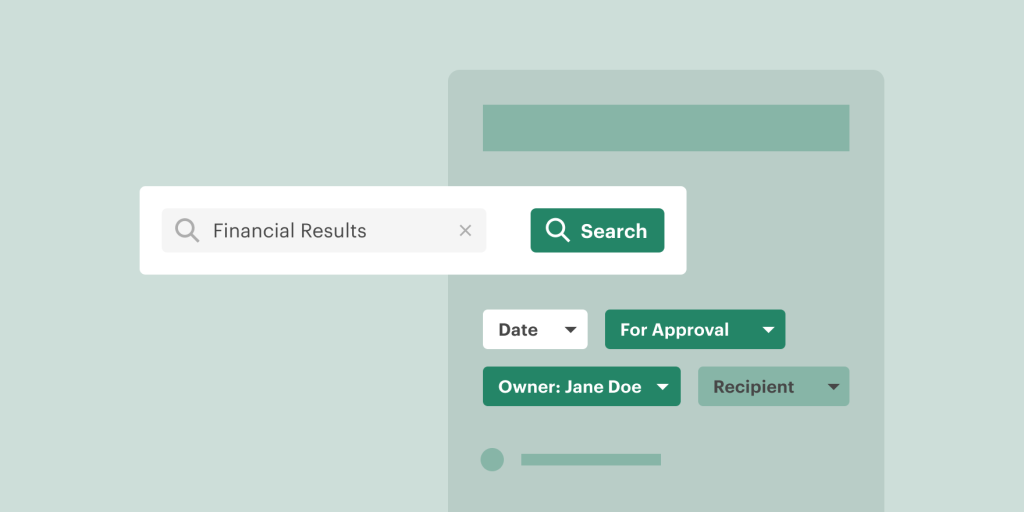
Use case
You’re the COO of a mid-sized software product company with contracts scattered across various departments.
You decide to leverage an AI tool for your contract management processes, which serves as a centralized repository for all contracts.
The system employs advanced optical character recognition (OCR) technology to digitize paper contracts and aggregates digital contracts from various departments.
With a few clicks, you can access any contract, search for specific terms, and view the entire contract history.
This clear transparency enables efficient tracking and management, and ensures easy access to vital contract information, simplifying contract governance.
6. Version control issues
Problem
Keeping track of contract versions, amendments, and revisions can be perplexing.
When you manage hundreds of contracts within one organization, it might lead to confusion.
Solution
AI simplifies version control, offering a comprehensive audit trail of contract changes.
An AI-powered tool for your contract management system maintains a complete history of contract versions, revisions, and amendments, ensuring clarity.
PandaDoc also provides a version history feature that allows you to switch between documents, templates, and content library items and view previous versions.
With this feature, you can easily track and manage document changes, ensuring transparency and accuracy in version control.
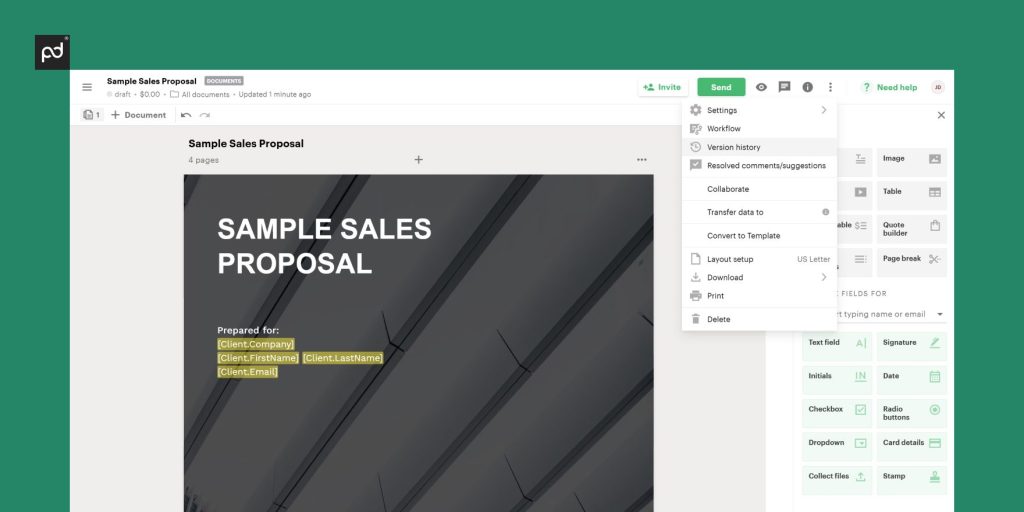
Key technical details:
- Version creation. Versions are automatically created when you open, edit, and close a document. Additionally, versions are generated when a document is sent, restored, or when a suggestion is added and accepted.
- Multiple user editing. When multiple users are editing a document simultaneously and one exits the document, the previous version is saved. The process continues as users exit, ensuring a comprehensive history.
Use case
Your company is expanding into new international markets.
This process means negotiating contracts with suppliers, partners, and clients in different regions.
To ensure seamless collaboration across time zones and among diverse teams, you employ an AI-powered solution that offers contract version control.
You’re currently in a complex negotiation with a European supplier.
Both parties have exchanged multiple drafts of the contract, including changes in currency, compliance requirements, and service level agreements.
With AI’s version control, you can access the complete contract history, including all versions, revisions, and comments made during the negotiation process.
Your legal team and the supplier’s representatives collaborate in real-time, viewing the latest version of the contract.
AI ensures that changes made by either party are instantly visible to all stakeholders.
For example, a potential conflict arises regarding the liability terms in the event of service disruptions.
AI’s audit trail helps you identify when and how this clause evolved, making it easier to resolve the dispute by mutual consent.
As changes are made, the platform tracks document versions automatically, ensuring everyone is working on the latest contract.
After a few negotiation rounds, the contract is finalized.
AI’s version control ensures that the signed contract is accurately recorded, and a comprehensive audit trail is maintained.
7. Lack of scaling
Problem
As organizations grow and the volume of contracts increases, scalability becomes a concern. Manual contract management processes may struggle to meet the growing demands, leading to inefficiencies and resource constraints.
Solution
AI can interact with established contract management solutions already designed to handle large volumes of contracts without compromising efficiency.
Use case
You own a tech startup experiencing rapid growth with a surge in contract volume.
Your startup secures a new round of funding, resulting in an influx of contracts for partnership agreements, investor relations, and new hires.
The AI tool you employed for your contract management system effortlessly accommodates the increased volume, maintaining optimal performance.
You continue to enjoy the same efficiency and accuracy in contract management, even as your business scales rapidly.
| Feature | Traditional approach | AI-powered approach |
|---|---|---|
| Contract Creation | Manual drafting, slow | Automated, rapid |
| Risk Identification | Manual, prone to errors | Automated, precise |
| Workflow Efficiency | Slow, manual processes | Fast, automated tasks |
| Data Extraction | Time-consuming | Quick and accurate |
| Contract Visibility | Fragmented and scattered | Consolidated and clear |
| Version Control | Confusing and complex | Simplified, easy-to-track |
| Scalability | Limited by resources | Scales efficiently |
| Text Quality | Subject to human error | Enhanced by AI |
| Accuracy | Human-dependent | AI-driven, high-precision |
What can AI do for smart contracts?
In the business world, smart contracts are like having an ultra-efficient assistant who ensures deals happen just as they should — the need for manual oversight or complicated paperwork becomes greatly reduced.
Say you own a business and want to buy goods or services. You agree on the terms, like the price, quantity, and delivery date.
Now, you bring in a digital helper, the smart contract. You feed it all the agreement details.
When the goods arrive, the smart contract checks everything. If everything checks out, it will automatically release the payment to the seller.
Let’s dig into some examples of how AI is revolutionizing smart contracts.
1. Automated execution
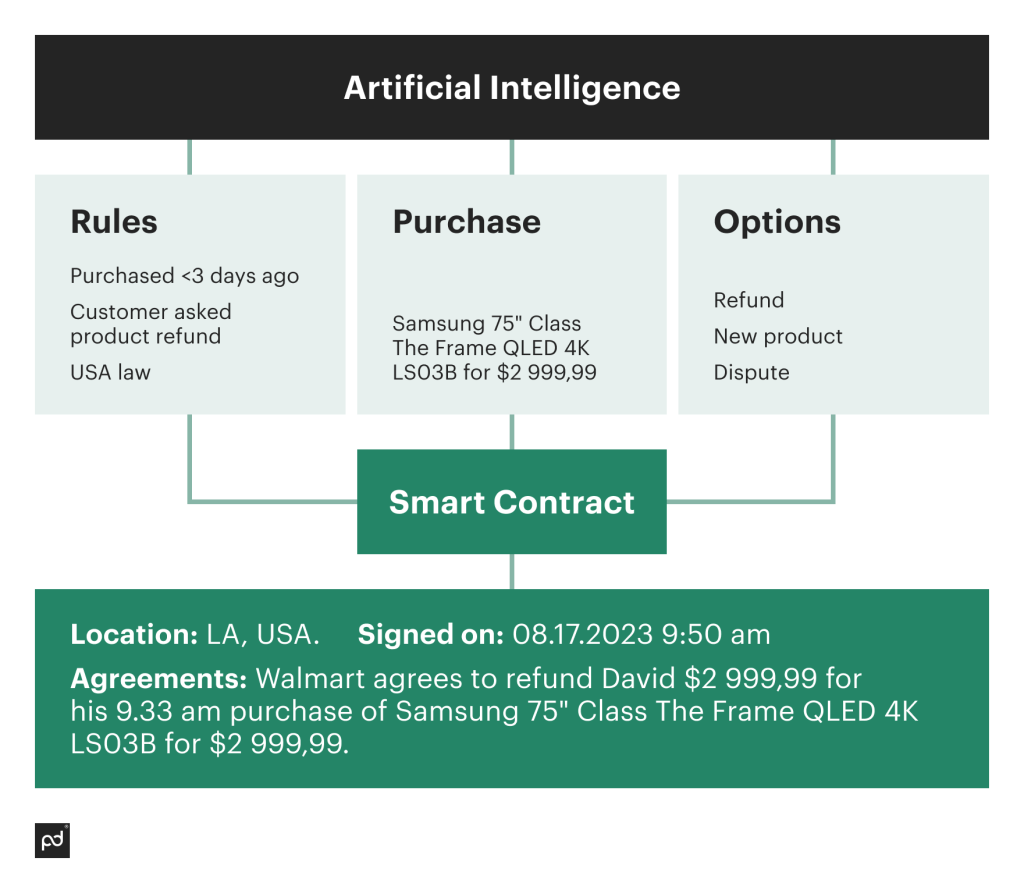
AI empowers smart contracts to execute autonomously when predetermined conditions are met.
This eliminates manual intervention and ensures that contractual agreements are fulfilled promptly.
Businesses benefit from increased efficiency and reduced error rates.
Example
You have an online shop and Black Friday sales have just kicked off. Orders are pouring in, and you’re excited about the surge in business.
But there’s a catch: you can’t monitor each order and manually approve them 24/7.
That’s where AI steps in, giving you the power to set conditions like payment confirmation and inventory levels.
No need for late-night order approvals; AI handles it all.
2. Data validation
AI can verify the accuracy and authenticity of data used within smart contracts.
This is particularly valuable in supply chain management, where the provenance of goods and the status of shipments can be cross-verified, guaranteeing compliance with contract terms.
Example
You’re a supply chain manager at a pharmaceutical company, and you’re tracking the journey of your latest medical goods.
AI meticulously verifies the accuracy of data, cross-referencing shipping logs, and product origins.
You can confidently assure your customers that their purchases meet the highest quality and compliance standards.
AI makes your supply chain transparent and trustworthy.
3. Natural language processing (NLP)
NLP enables smart contracts to comprehend and interpret human-readable contract terms.
This simplifies the contract creation process, allowing parties to draft contracts in plain language, which AI then translates into executable code.
The result? Contracts that are more accessible and less reliant on technical jargon.
Example
You’re a startup founder eager to secure an ultimate deal with a tech giant.
This is your chance to end up with your first unicorn.
You draft your contract in plain, human-readable language, just like you’re writing an email.
Then AI transforms your words into smart contract code, making your proposed agreement crystal clear.
No more confusion, no need for costly legal experts.
4. Dynamic contracting
AI facilitates the dynamic adaptation of smart contracts in response to changing circumstances.
For instance, in the insurance sector, AI-powered smart contracts can adjust premiums or coverage in real-time based on relevant data, ensuring that contracts remain relevant and equitable.
Example
As an insurance provider, you’d want to offer your customers and partners the best coverage at the right price, even as risks evolve.
AI continuously analyzes real-time data, adjusting premiums and coverage instantly based on changing risk factors.
Your clients get the protection they need at competitive rates, and you stay ahead in a dynamic market — AI is your adaptive partner.
Additional details
With PandaDoc’s conditional smart content tool, you can effortlessly adjust contract terms in real time based on changing risk factors.
This ensures that your clients always receive optimal coverage at competitive rates.
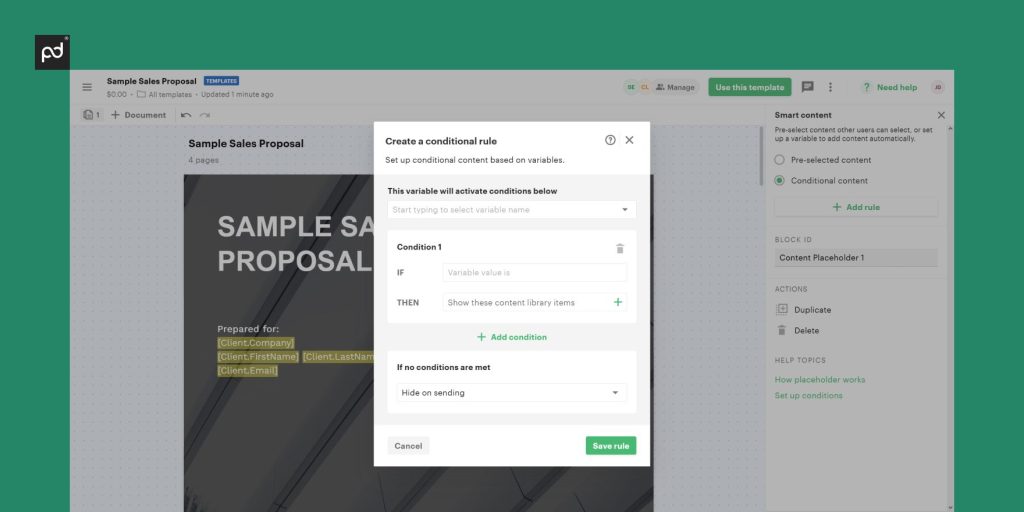
Here’s how it works:
- Setting up rules. Begin by adding a smart content block to your template. Within this block, you can establish rules that dictate dynamic content changes based on variable values. You can create up to 50 conditions per rule.
- Content library integration. PandaDoc provides a content library where users can store pre-approved clauses, sections, or content blocks. Think of your content library as your trusted toolbox. Settle your smart content block with pre-selected items that seamlessly integrate into the contract, just like adding the perfect tools to your toolkit for a specific job.
- Real-time adaptation. When a contract is generated from the template, conditional smart content evaluates the defined conditions. If a condition aligns with the contract’s context, it dynamically populates the contract with the specified content. If no conditions are met, default content is used.
- On-the-fly corrections. Should a mistake occur or if conditions change after contract generation, you can easily rectify this. Access the variables tab, find the relevant variable, and update it. The smart content block will instantly auto-update to reflect the change.
5. Predictive analysis
AI provides invaluable insights for crafting more robust contracts by leveraging historical contract data and market trends.
It can anticipate potential risks, recommend improvements to contract terms, and help businesses create agreements that align better with their objectives.
Example
Leveraging historical contract data and market insights, AI doesn’t just react; it anticipates, providing you with recommendations to improve your contract’s worthiness.
You’re the captain of a ship charged with navigating stormy financial seas.
AI is your weather forecaster, not just predicting the next crisis tsunami but helping you steer clear of it.
With AI, your contracts aren’t just agreements; they’re strategic tools, always ready to help weather the next business storm.
6. Rock-solid security
AI contributes to the security of smart contracts by proactively identifying vulnerabilities and potential threats.
It monitors contract activity, swiftly detecting unauthorized access or suspicious behavior, bolstering the overall security posture.
Example
You manage a blockchain-based platform for digital transactions, and you rely on smart contracts to ensure secure and transparent transactions.
Here’s where AI steps in as your digital sentry.
It continuously monitors the blockchain network, analyzing transaction patterns, and flagging any anomalies.
It’s like a digital bouncer at a high-end club, checking every guest’s credentials.
When AI detects unusual behavior, it immediately triggers alerts and, in some cases, can even automatically freeze certain transactions to prevent potential threats.
However, it doesn’t just sound alarms and detects unauthorized access or suspicious behavior; it identifies potential threats before they can even approach.
This proactive security technique not only protects your platform but also maintains your users’ trust.
Like a digital fortress, AI ensures your contracts remain impenetrable, providing you with the peace of mind to focus on your mission: business success.
7. Dispute resolution
AI offers a transparent and impartial mechanism for resolving disputes within smart contracts.
By analyzing contract code and transaction data, AI can objectively determine whether contractual conditions have been met, reducing the reliance on costly legal operations.
Example
You’re a business owner dealing with a dispute over a complex contract clause.
In the past, this might have meant lengthy legal battles and considerable expenses.
Backed by AI, it’s a different story.
AI is like a brilliant legal analyst.
It analyzes smart contract code and transaction data and cross-references it with relevant legal precedents and industry standards.
Within minutes, AI generates a comprehensive report, highlighting the strengths and weaknesses of each party’s argument.
It even suggests potential resolutions based on legal best practices.
In a negotiation meeting, AI acts as your knowledgeable advisor, providing real-time insights and guiding the discussion toward a swift and fair resolution.
The result? Reduced legal costs, faster dispute resolution, and a stronger business relationship.
The infusion of AI into smart contracts not only streamlines their execution but also empowers them to adapt to an ever-changing business environment.
As AI technology advances, the capabilities it brings to smart contracts will expand, promising enhanced efficiency and security in contractual processes.
Additional details
As a part of the CPQ add-on, PandaDoc offers a conditional approvals feature.
Available within the enterprise plan, it enables documents to proceed for approval only when specific conditions, based on values from the quote builder block, are met.
Should these conditions remain unmet, the document automatically moves to an approved status.
Setting up conditional approvals is a straightforward process.
- Access workflow. Start by opening your PandaDoc template and selecting “Workflow” from the top menu.
- Select approvals. Within the workflow settings, you’ll find the “Approved” tile.
- Add approvers. Specify the individuals or groups responsible for approving the document.
- Set conditions. This is where conditional approvals come into play. Click the “+add condition” button to establish specific conditions based on values from the quote builder block.
- Save configuration. After configuring your conditions, save the setup.
Wrapping up
Artificial Intelligence is more than just a buzzword. It’s a transformative force reshaping the contract management landscape.
As organizations continue to embrace the future, harnessing the capabilities of AI is not just an option; it’s a necessity for staying competitive, efficient, and agile in a rapidly evolving world.
Unlock the full potential of your contract management endeavors with Panda AI’s innovative solutions.
Frequently asked questions
-
AI in contract management involves using machine learning and natural language processing technologies to automate and improve various aspects of the contract lifecycle, such as drafting, reviewing, analyzing, and managing contracts.
-
AI in contract management operates through technologies like natural language processing (NLP) and machine learning (ML). NLP helps AI systems understand and extract information from contracts written in human language, while ML enables them to learn from historical contract data, improving accuracy and efficiency.
-
Using AI in contract management can lead to benefits such as automation of repetitive tasks, improved accuracy, faster contract cycles, better risk management, and enhanced collaboration among legal professionals and contract managers.
-
Yes, AI can assist in drafting contracts by suggesting clauses and alterations. It can also analyze contracts to identify potential risks and compliance issues, making negotiations more efficient.
-
AI enhances smart contracts by automating execution, validating data, simplifying contract terms using NLP, enabling dynamic adaptations, providing predictive insights, ensuring security, and offering mechanisms to expedite dispute resolution.
Disclaimer
PandaDoc is not a law firm, or a substitute for an attorney or law firm. This page is not intended to and does not provide legal advice. Should you have legal questions on the validity of e-signatures or digital signatures and the enforceability thereof, please consult with an attorney or law firm. Use of PandaDocs services are governed by our Terms of Use and Privacy Policy.
